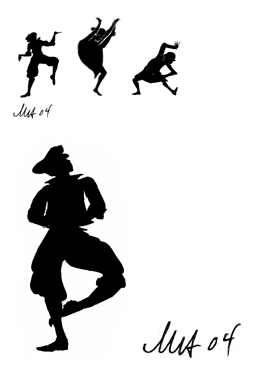|

|
On
April 7, 8, 9 Princeton University will stage
Serge Prokofiev's infamous 'Soviet' ballet, Le Pas d'Acier,
originally conceived in 1925. The project is being directed
by Professor Simon Morrison, a musicologist specializing in
Russian music and ballet. The ballet will be developed from
the research of ballet/theatre historian Lesley-Anne Sayers,
and staged by internationally renowned reconstructors Millicent
Hodson and Kenneth Archer. Hodson is developing new, source-based
choreography to take the ballet back to its original conception
and its roots Soviet musical theatre, dance , and revolutionary
era of the 1920s.
This production will use an unpublished scenario co-written
by Soviet designer Georgi Yakoulov and Serge Prokofiev in
1925. The original ideas for the staging and narrative content
were adapted for the ballet's premiere by Diaghilev's Ballets
Russes in 1927. This project aims to present the ballet as
collaboratively conceived in 1925. It is therefore the first
staging of the music alongside the action for which it was
written
In conjunction with the ballet performance, an exhibition
in the Leonard L. Milberg Gallery for the Graphic Arts in
Firestone Library will open on April 1, 2005. “Pas
d'Acier (The Steel Step): The Re-creation of a Lost Ballet”
will feature a model reconstruction of Yakoulov's design,
built by Peter Sayers from the research of Lesley-Anne Sayers. The visually-spectacular set
of the ballet, which will be performed in the Berlind Theatre,
is a replica of the one that originally was planned for the
ballet by Yakoulov. Dr. Sayers spent eight years researching
and creating models of the set, which is a stylized mechanical
world of brightly colored spinning wheels, gears, levers and
a rotating conveyor belt representing factory life. Surrounded
by Yaloulov's original drawings for the set, this model promises
to be highlight of the exhibit. The exhibition will also present
documentation of designs from the 1927 Paris production: photographs,
drawings, as well as posters from the Meyerhold Theatre where
the original 1925 production would have taken place.
|
|
Drawing on the holdings of the Library's Special Collection
- especially materials from the Graphic Arts Collection, the
Allison Delarue Collection of theater and dance materials,
and the Cotsen Children's Library. The exhibition opens with
a snapshot of the Ballet s Russes from the first two decades
of the twentieth century. Early Ballets Russes productions
created images of exotic escapism, revived a world of romantic
fairytales, and introduced the folklore of early Russia. We
see children's books of that era, a vivid costume design by
Leon Bakst, neo-classical program covers of period productions,
and modernist Picasso costume drawings. The manuscript sketch
of George Antheil's Ballet mecanique, along with the Pianola
rolls, helps demonstrate the fast changing artistic styles,
progressing toward the eventual interaction with constructivism
represented by Pas d'Acier. The Princeton production will
be represented by photographs documenting the re-creation
process, costume designs, choreographic drawings by Millicent
Hodson, and a costume and props used in the April performance.
The opening will be preceded by a lecture to be given by
Professor Morrison of the Princeton Music Department, "Finding
a Lost Ballet" at 5:00 pm, April 1 in McCormack 101 and
will be from 6 pm - 8 pm in the Leonard L. Milberg Gallery
in Firestone Library.
The exhibition will remain open through September 25, 2005.
Funding for the entire campus projects has come from a wide
variety of sources, including the Friends of the Princeton
University Library: the Council for the Humanities, the Department
of Music, the Department of Slavic Languages and Literatures,
the Office of the President, the Office of the Dean of the
Faculty, the Program in Theater and Dance, the Program in
Russian Studies, the Department of Rare Books and Special
Collections, Princeton University Library, and the United
Kingdom Humanities Research Board.
|
 |
| In addition, an on-line Alumni
Studies course, "How Ballet Works: Dance, Music and
the Reconstruction of a Lost Masterpiece" will begin
March 9, and will be taught by Professor Morrison. For
further information contact Kaitlin Lutz at klutz@princeton.edu
or 258-0014. |
|